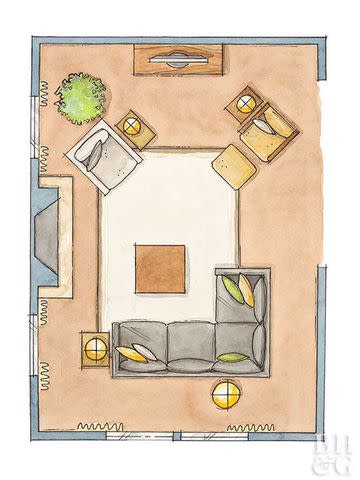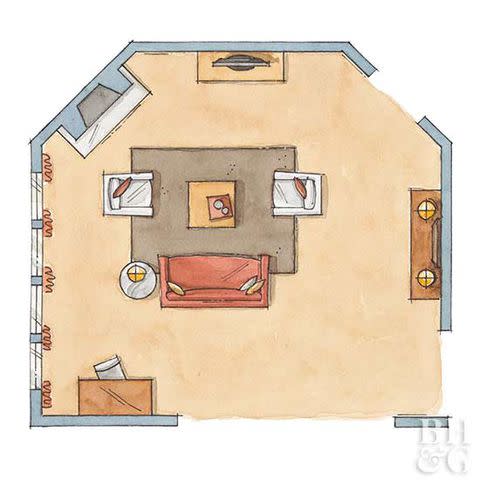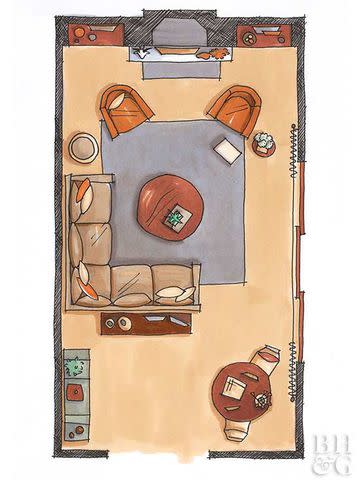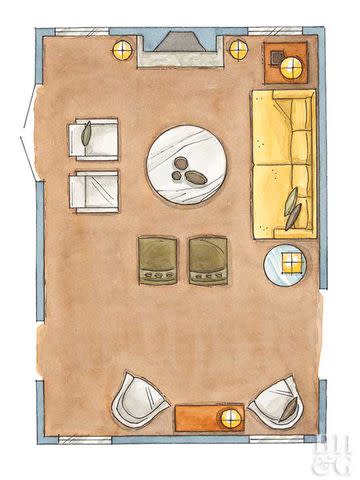Living Room Layouts to Make the Most of Your Gathering Space
Get tips for arranging living room furniture in a way that creates a comfortable and welcoming environment.

The proper living room layout makes the space feel welcoming for family nights, book club gatherings, holiday celebrations, and so much more. No matter how attractive, a living room layout where people sit in chairs and on sofas pushed against the walls or too far apart works against conversation and a sense of togetherness. Instead, seating should be placed close together so everyone can converse comfortably and feel part of the action.
How to arrange living room furniture depends on the natural focal point of the space. In some rooms, this is architectural, such as a fireplace or a set of windows. In others, the focal point is a television. Once you determine this feature, orient the seating toward it. Find ways to create zones in a large living room layout to create zones for game-playing, quiet reading, or lounging.
Related: The 15 Best Sectionals to Lounge in Style and Comfort
Flexible Living Room Layout

Your living room layout depends on your needs and preferences and what pieces you have. Most of us have a sofa and another chair or two, which we can reposition as needed. When trying out new living room furniture arrangements, there should be enough space between furnishings so people can easily move past them in search of a comfy spot. And give everyone a reachable drink rest, even if it's just a stack of books on an ottoman.
Related: 11 Living Room Decor Ideas for a Refresh that Won’t Blow Your Budget
Focal Point Living Room Layout

The most functional living room layout places the sofa across from the focal point, with all other pieces angled to face the same direction. This allows everyone a good look at the television or crackling fire. When entertaining, round the grouping into a conversational circle by adding ottomans or pillow poufs that face back at the sofa. These additional seating options make creating a living room layout with the fireplace or the TV as the focal point easier.
Related: Types of Fireplaces and the Pros and Cons of Each
Small Living Room and Multiple Doorway Layout

For a living room layout with multiple doorways, draw an imaginary line that angles through the room from opening to opening, creating a straight trail between furniture pieces. This dynamic arrangement keeps the focal point in mind but also directs people through the space, which is key for figuring out how to arrange furniture in a small living room. Blocking the room's corners like this can be helpful when you have children's toys or hobby supplies you'd like to hide.
Related: 15 Small Living Room Furniture Arrangements That Maximize Space
Sectional Sofa Living Room Layout

When a sectional sofa is your primary seating, you might be tempted to push it into the corner of the room and call it a day. But this can feel claustrophobic, especially for people seated on the middle cushions. Pull it away from the wall to let light and air flow around it. Place a standing lamp or slender console table at the back, and put any other seating across from both ends of the L. A sectional can act as a divider in a long room, creating space for a game table, home office space, or kids' play area.
Related: Ideas for a Functional Home Office in Any Room of Your Home
Symmetrical Living Room Layout

A traditional and popular living room layout idea is face-to-face seating. Two sofas (or a sofa and a pair of chairs) sit directly across from one another, with the focal point at one end. Positioning the seating this way facilitates conversation since everyone can easily see each other. It's useful when activities such as reading, working on a laptop, or listening to music are just as important as watching television.
Related: 26 Expert Tips to Help You Arrange Furniture in Every Room
For more Better Homes & Gardens news, make sure to sign up for our newsletter!
Read the original article on Better Homes & Gardens.